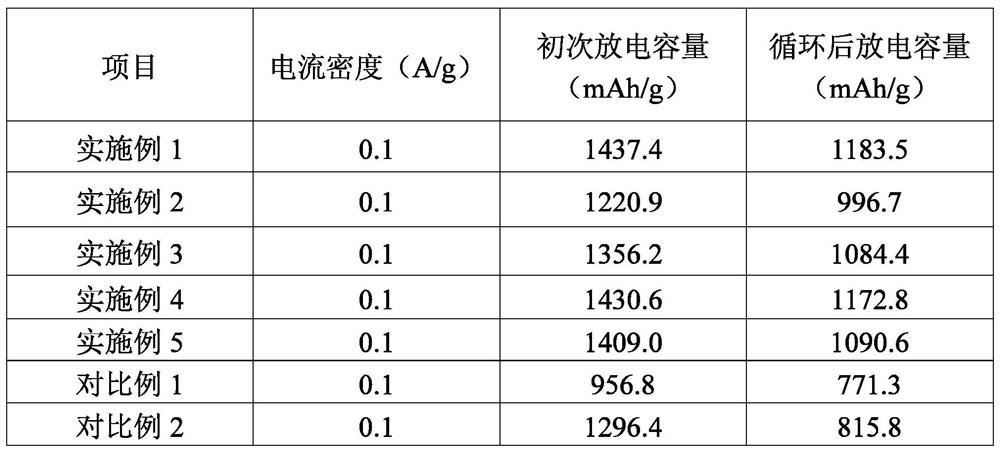A kind of lithium-ion capacitor battery and preparation method thereof
A capacitor battery and lithium-ion technology, which is applied in the field of lithium-ion capacitor batteries and its preparation, can solve the problems of poor cycle stability of electrode materials, and achieve the effects of enhancing electrochemical activity, accelerating transfer, and improving stability
- Summary
- Abstract
- Description
- Claims
- Application Information
AI Technical Summary
Problems solved by technology
Method used
Image
Examples
Embodiment 1
[0032] A preparation method for a lithium-ion capacitor battery, comprising the steps of:
[0033] (1) Preparation of positive electrode: 80g LiCoO 2 , 10g of binder PVDF and 10g of conductive agent tantalum were added to 300mL of N-methyl-2-pyrrolidone and dispersed evenly to obtain a positive electrode slurry, which was then coated on a 15μm thick aluminum foil, dried and rolled to form a positive electrode ;
[0034] (2) Preparation of negative electrode: 90g nitrogen-doped porous carbon supported MoS 2 Nanoflowers and 10g of binder PVDF were added to 300mL of N-methyl-2-pyrrolidone, dispersed uniformly to obtain a negative electrode slurry, and then the resulting negative electrode slurry was coated on a 12 μm thick copper foil, dried and rolled to form a negative electrode; Nitrogen-doped porous carbon supported MoS 2 The preparation steps of nanoflowers are as follows:
[0035] Add 45g of 3,3'-diaminobenzidine into 300mL of tetrahydrofuran solvent, stir evenly, then ...
Embodiment 2
[0041] A preparation method for a lithium-ion capacitor battery, comprising the steps of:
[0042] (1) Preparation of positive electrode: 80g LiCoO 2 , 12g of binder PVDF and 6g of conductive agent tantalum were added to 300mL of N-methyl-2-pyrrolidone, and dispersed evenly to obtain a positive electrode slurry, and then the obtained positive electrode slurry was coated on a 15 μm thick aluminum foil, dried and rolled to form a positive electrode ;
[0043] (2) Preparation of negative electrode: 90g nitrogen-doped porous carbon supported MoS 2 Nanoflowers and 12g of binder PVDF were added to 300mL of N-methyl-2-pyrrolidone, dispersed uniformly to obtain negative electrode slurry, and then the resulting negative electrode slurry was coated on a 12 μm thick copper foil, dried and rolled to form a negative electrode; Nitrogen-doped porous carbon supported MoS 2 The preparation steps of nanoflowers are as follows:
[0044] Add 54g of 3,3'-diaminobenzidine into 300mL of tetrahy...
Embodiment 3
[0050] A preparation method for a lithium-ion capacitor battery, comprising the steps of:
[0051] (1) Preparation of positive electrode: 80g LiCoO 2 , 12g of binder PVDF and 8g of conductive agent tantalum were added to 300mL of N-methyl-2-pyrrolidone, dispersed uniformly to obtain a positive electrode slurry, and then the obtained positive electrode slurry was coated on a 15 μm thick aluminum foil, dried and rolled to form a positive electrode ;
[0052] (2) Preparation of negative electrode: 90g nitrogen-doped porous carbon supported MoS 2 Nanoflowers and 13g of binder PVDF were added to 300mL of N-methyl-2-pyrrolidone, dispersed uniformly to obtain negative electrode slurry, and then the resulting negative electrode slurry was coated on a 12 μm thick copper foil, dried and rolled to form a negative electrode; Nitrogen-doped porous carbon supported MoS 2 The preparation steps of nanoflowers are as follows:
[0053] Add 62g of 3,3'-diaminobenzidine into 300mL of tetrahyd...
PUM
 Login to View More
Login to View More Abstract
Description
Claims
Application Information
 Login to View More
Login to View More - R&D
- Intellectual Property
- Life Sciences
- Materials
- Tech Scout
- Unparalleled Data Quality
- Higher Quality Content
- 60% Fewer Hallucinations
Browse by: Latest US Patents, China's latest patents, Technical Efficacy Thesaurus, Application Domain, Technology Topic, Popular Technical Reports.
© 2025 PatSnap. All rights reserved.Legal|Privacy policy|Modern Slavery Act Transparency Statement|Sitemap|About US| Contact US: help@patsnap.com

